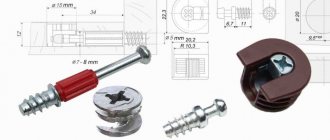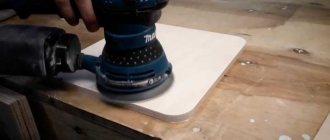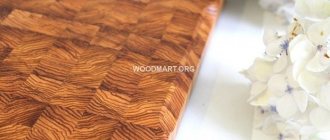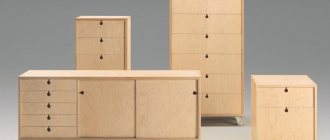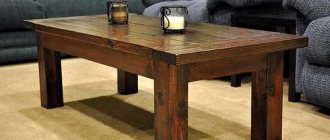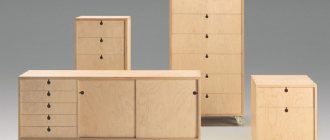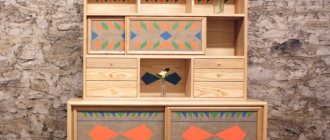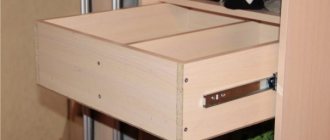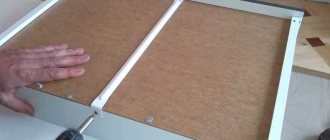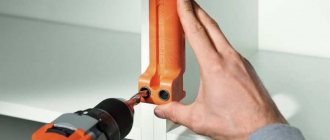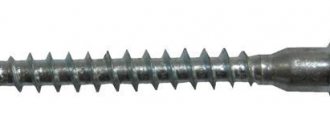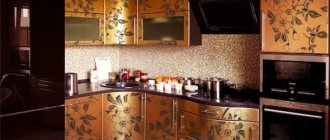Furniture fasteners are used to connect furniture elements. Its use makes it possible to reduce the cost of production in comparison with more complex fixation techniques such as tongue-and-groove or dovetail. In addition, the use of fasteners often makes it possible to avoid fastening furniture elements with glue. This makes it collapsible and facilitates transportation. When purchasing furniture, the connection of which is ensured by modern fasteners, it is delivered unassembled, so it is easier to bring it into apartments, houses and offices.
What types of furniture fasteners are there?
Modern types of fasteners include:
- Self-tapping screw.
- Confirmation.
- Eccentric coupler.
- Intersectional screed.
- Table top screed.
- Furniture corner.
- Rafix.
- Stock.
Self-tapping screw
This is a budget-friendly and common type of fastener that is used to connect two planes to each other. Hooks, loops and some types of handles are also attached using self-tapping screws. Self-tapping screws are cheap and screw in very quickly, especially when using a screwdriver. The disadvantage of such a screed is its weak fastening. Self-tapping screws are not suitable for all materials. They can be used on natural wood because its fibers hold the fastener threads securely. In the case of MDF or chipboard, they break out under load. When assembling furniture, before screwing in a self-tapping screw, it is recommended to first drill a hole to match its length, but with a smaller diameter. This will prevent the wood from cracking along the grain. This rule is mandatory when working with hardwood furniture.
Confirmat
This is a specialized screw tie that has a wide thread that provides a more secure fastening than a screw. Confirmat is only slightly more expensive, but it can work with chipboard and MDF. Before using it, it is also necessary to prepare the hole. Fastening is suitable if the furniture will be assembled and installed in one place without the need to further disassemble and transport it. The fact is that if the confirmat is often unscrewed and screwed in, then the cut thread in the chipboard or MDF is damaged and the screw is no longer held. In this case, a wooden chip is glued into the damaged hole. After drying, new drilling is carried out in it and the confirmat is screwed securely. This mount is not compatible with conventional Phillips screwdrivers. It requires a hex wrench, which is very inexpensive. It always comes with furniture.
When working with confirmat, screwing must be done with extreme caution, since if excessive force is applied, the thread will break. When using this fastener, its heads, recessed into the furniture, remain visible, which negatively affects aesthetics. To solve this problem, special plastic plugs are provided that are inserted into the hole for a hex key. Of course, they cannot completely solve the problem of visibility, but they make the furniture look more attractive.
Eccentric coupler
This fastener is also called minifix. It is used when it is necessary to connect furniture parts at right angles. The device consists of two elements: a rod and an eccentric. The cost of such fasteners is an order of magnitude higher than that of confirmed or self-tapping screws. To install it, you need to carry out precise drilling. In the future, when assembling, a screwdriver or screwdriver . Minifix can withstand repeated assembly and disassembly without damaging the mounting sockets. The eccentric coupler is invisible, so it is used when it is necessary to connect the front and side parts of furniture.
When using such furniture fasteners, you must also use a special Forstner drill. Private craftsmen who make furniture often refuse to use an eccentric coupler, since it requires complex high-precision drilling. In industrial production there are precision machines that eliminate errors, working according to a template or under CNC control, which makes it possible to install a minifix without any problems.
Intersectional screed
This type of fastener is designed specifically for tightly tightening sections of furniture together. It consists of a classic screw and a tall nut into which it is screwed. On its back side there is a cap that prevents the fasteners from passing through the prepared hole. Using a tie, you can tightly connect two cabinets together, which will add stability to them and prevent the formation of cracks. The height of the intersection screed can be varied, depending on the thickness of the surfaces that need to be connected.
Such furniture fasteners are usually installed in each corner of the furniture. It is placed 3-5 cm from its ends. To carry out precise drilling, the elements are usually first fixed together using a clamp. After that, one through hole is prepared, into which an intersectional tie is threaded.
Table top screed
Such furniture fasteners are used to tighten two parts of the tabletop together. Most often it is used when assembling kitchen furniture. Typically, 2 or more ties are used to connect tabletops to increase reliability. This fastener consists of a long bolt, a nut and a pair of rectangular rounded washers. To make the connection, a non-through wide hole is made with a feather drill on one and the second section of the tabletop. After this, a groove is cut between them and a tie is inserted. Using a screw, it is tightened, pressing the halves of the tabletop tightly.
Furniture corner
This is a budget method of connection, with which 2 parts are attached at right angles. It is used only if there will be a slight load on the furniture fasteners. Sometimes shelves are fixed using a corner, but in this case they can only be removed after it is disconnected. This fastener is held in place with self-tapping screws, which is the reason for its low efficiency. The fact is that only short screws can be used, which is due to the small thickness of the parts.
The reliability of the corner depends on its size. If its sides are long and it is possible to screw in several screws, then such fasteners can withstand quite serious loads, especially if made of steel or aluminum. For less critical fastenings, plastic corners with a lid are used to cover the screw heads.
Read also: Designation of the start-stop button on the diagram
Rafix
This furniture fastener is a type of eccentric coupler used to connect two pieces of furniture. It can be used to secure shelves. This device allows for simpler installation than using a minifix. This is due to the possibility of less precise drilling. This connection allows assembly and disassembly without causing damage to the parts being removed. The fastener itself consists of a coupling or dowel, which is inserted into the hole of one part, and a screw to secure it. A plastic eccentric is fixed to it, installed on the second piece of furniture. The eccentric is mounted in a large hole made with a Forstner drill.
Stock
This is the cheapest and oldest furniture fastener. It is also called chopik and dowel. It is a small wooden rod made in a cylindrical shape with chamfers on both ends. It is made from hard wood. Sometimes you can find plastic products. The surface of the rod is corrugated, which is necessary for better coating with wood glue. It is also possible to use a chopik without glue, but in this case the connection is less reliable.
This fastener is used to connect two furniture elements. To do this, holes are drilled in them opposite each other so that they fit together. After this, a small amount of glue is poured into them and the dowel is driven in. This connection method is quite reliable, but in the future it will not allow for safe disassembly of the furniture in the event of a move. The rod is cheap, so it is often used when assembling budget cabinets and desks that will be subject to light load.
Materials and colors
Furniture fasteners made of steel are considered the best. They are more resistant to loads, so when using them the assembly will be more reliable. For their production, ordinary steel is used, and therefore it is coated with a layer of zinc to protect against corrosion. Sometimes you can find black fasteners on sale, which is very rare. When using confirmat, there are no special requirements for color, since the visible caps are covered with plugs, the shade of which is already matched to the furniture. For self-tapping screws, color is important because they are often noticeable, especially when used to attach door hinges. They come in silver, black and gold.
Aluminum products are used much less often than steel fasteners. Their disadvantage is their increased thickness, since this metal is prone to deformation under load. Typically, corners are made from aluminum, as well as eccentrics for minifix and rafix.
In the production of certain types of fasteners, plastic is used. First of all, it is used for the manufacture of angles and rafix, namely the body of its eccentric. Plastic elements can have different colors. On sale you can find white, black, brown, etc. With corners, color is really important because they tend to be visible.
Only the stem is made of wood. It is made from different types of wood, so its shade may vary. This element is completely hidden.
To ensure high quality assembly and installation of interior elements, furniture fasteners are used. Depending on the location of fixation and method of connection, there are several varieties. These elements not only make the assembly and installation procedure easier, but will also be invisible after the process is completed.
Eccentric coupler furniture installation, furniture assembly, instructions
Furniture eccentric screed is one of the types of fasteners used in furniture production. It allows you to hide the places where parts are attached, which has a positive effect on the design of products. Another advantage of an eccentric tie is that it allows you to repeatedly assemble and disassemble furniture without losing the strength of the connections, for example, during transportation. However, for all its advantages, it is more difficult to install than other types of furniture fasteners. Therefore, it is very important to correctly follow all installation instructions provided in this article.
Content
Installation of an eccentric couplerMarking for an eccentric couplerAdditive for an eccentric coupler
Assembling furniture with eccentric couplers is performed in the following sequence. The coupler consists of two parts: an eccentric and a rod. The operating principle of this fastener is very simple. The rod is attached to one part, and the eccentric to the other. Next, the parts are connected and the eccentric is turned, which fixes the parts. Assembly and disassembly of furniture using eccentric ties is very quick and easy, which is a great advantage of this type of fastener.
Fig.1.
Assembly diagram of an eccentric coupler. This scheme is identical for assembling any furniture and eccentric couplers of any configuration.
An eccentric coupler can have different sizes of both rods and eccentric. The most common is a 15 mm eccentric. The rod can have sizes of 10, 26, 34 mm. The size of the eccentric coupler is selected based on the application conditions. So, for shelves, a rod with a length of 10 mm is suitable, and for connecting furniture parts, choose 26 or 34 mm.
What do you need to know before purchasing?
They differ:
- eccentric diameter and height;
- stand length;
- type of rack fastening (screw or self-tapping screw);
- type of nut (futorka).
Photo 9 – Tie Ø 15 with Euroscrew
Connector operating principle
When assembling the product, a rod with a T-shaped head passes through a hole in the end of the main part. Its head is in the middle of the transverse hole. An eccentric is installed there, which grips the rod head with its inner side.
During the next turn, the eccentric rotates in the hole and acts on the head of the rod - first it brings the parts to be connected together, and then creates the necessary force in the connection.
Photo 10 - Eccentric + self-tapping eccentric rod
The coupler consists of a cast metal eccentric, a nozzle and a rod. There are many designs in which the rod is wrapped in the material of the attached part without a nozzle.
IMPORTANT! Eccentrics with a diameter of 25 mm, and sometimes 15 mm, must be closed with a plastic plug.
Screeds are distinguished by the diameter of the eccentric. The larger it is, the greater the stroke of the tie and the greater the possible force. Eccentrics with a diameter of 25, 15 and 12 mm are used.
Photo 11 - Screed with self-tapping screw
Flaws
During operation, the fasteners may become loose. To solve this problem, manufacturers make the working surface of the eccentric concave, and the spherical working surface of the rod head is in contact with it. In other designs, the internal working surface of the eccentric is stepped, and the adjacent working surface of the rod head is flat.
Photo 12 - ST01-49-3-Br-01
In this case, the outer surface of the eccentric is equipped with oblique smoothed teeth, inclined in the opposite direction from the direction of its rotation during assembly. This increases adhesion to the material of the part, additionally preventing its spontaneous rotation and loosening of the connection during operation.
Photo 13 — Dowel Quickfit 05129 + Eccentric 09537
Photo 14 - ST01/46/6/Zn/01
The notches inside the eccentric increase its grip on the rod three times compared to a smooth flat surface.
Such fasteners require the exact relative position of all mating holes. Drilling these holes in the knee will cause the cam to break.
Scheme 1 - Example of screed organization
Installing an eccentric coupler
When connecting parts with an eccentric coupler, it is important to strictly observe the installation dimensions. Correct installation of the tie will ensure an accurate connection of the parts. The installation dimensions for all types of eccentric couplers are the same, with the exception of the rod dimensions, which were mentioned earlier.
Fig.2.
Installation of an eccentric coupler. The installation diagram and installation dimensions are shown in the drawing. The necessary grooves are made in the parts to be connected, after which the rod and eccentric are installed and the parts are tightened.
When connecting parts with an eccentric coupler, it is important to monitor the position of the rod relative to the eccentric. If the rod is tightly twisted, then the eccentric cannot be rotated 180 degrees and the connection will not be secured; if the rod is not tightened, then it will not be possible to tightly connect the parts with an eccentric tie.
How to use a tie: fixation
Eccentric fasteners are used to connect two parts of a product. Let's look at the principle of its operation using the example of fastening a table leg.
How to install a screed in a desk part?
In the upper part of the table leg, you need to drill two holes for the metal retainer.
Two similar holes are drilled on the end of the table (above the newly made holes). As a result, we get an end-to-end channel.
Marking for eccentric coupler
Before you start making grooves for the eccentric tie, you need to make markings. The markings are quite easy to do manually using a ruler. To do this, it is convenient to place the parts to be connected on top of each other with a slight offset and make marks for the grooves.
Fig.3.
Marking the eccentric coupler. Marking can be done manually. If carried out carefully, this will not affect the installation of the eccentric coupler.
A more convenient and accurate way of marking is to use a special template. The template for the eccentric coupler allows you to accurately mark the installation location and avoid making mistakes. You can buy it ready-made or make it yourself.
We mark and connect the parts using shelf support ties with short pins
So, we mark a hole for a short pin with a self-tapping thread.
Then, on the mating part, at a distance of 9.5 mm from the edge, mark the center of the hole for the eccentric.
Next, I use a 5 mm drill to drill a blind hole for the pin, and on the mating part, using a 20 mm Forstner drill, I drill a blind hole for the eccentric.
I screw in the pin and install the eccentric in the housing into the mating part.
I connect the parts, after which I turn the eccentric to fix it.
Once again I would like to repeat, for better marking and drilling of parts, it is advisable to use jigs, thanks to which the accuracy, quality and speed of work increases, and the money spent on a jig will come back to you in the form of no defects, saved effort and time.
Furniture screed RAFIX 20 white for parts with a thickness of 16 mm or more, flush mounting
Draw your attention to!
Before paying for your order, please check whether the selected products and accessories fit the size of your furniture or the features of your interior!
Just call us or write using the contacts from the site header - this is the easiest way to place an order or get a consultation! We are always ready to help with advice before purchasing!
It’s very easy to purchase the product you need in the online store Hafeleshop.ru
: 1. First you need to go through a simple registration. Depending on whether you are a retail or wholesale buyer, an individual or a legal entity, you will be offered fields to fill out. 2. Then add the selected products to your cart using the search, catalog or Hafele article numbers known to you. 3. Once you have completed selecting the items you need, go to your cart and then click on “Place an order” in the lower right corner.
Next, you will receive a written confirmation of your order to your email address that you provided during registration. And soon after that, expect a call from our manager who will answer all your questions about the order.
Registration upon first purchase
Go to the Login/Registration page (the link to it is in the upper right corner on all pages of the site) and fill out the form provided (form options are available for retail and wholesale types of purchases, as well as for legal entities and individuals). Required fields are marked with an asterisk.
Complete the form and an email with your registration details will be sent to the email address you provided.
How to place an order
Having selected the product you like in the catalog, click on the “Add to cart” button to place this product in your order basket. You can always see information about the number of items in the cart and the current amount of orders in the upper right corner on all pages of the site. More detailed information about the status of the order basket is available by clicking on the “My order” link. From there you can go directly to placing your order.
In the order, as well as in the product card, you can once again look at the photographs of the product, study the characteristics, instructions for installation, installation and operation, and also watch a video about the product.
How to place an order
In your order basket, you can select a payment method, delivery operator and review the list of products again, changing the number of units if necessary. On the first page of checkout, you will be asked to review the list of products again, where you can delete individual items, as well as change the quantity for each item in your order. You can also print your order or download a PDF file. If you have a promotional code for a discount, you can enter it in the appropriate field at the bottom of the page. After completing all the necessary operations, click on the “Place an order” button in the lower left corner.
In the next window, select the payment method and delivery type that suits you and click on “Continue checkout”.
In the window that appears after, continue registration. To do this, fill in your contact information and the address where the order will be delivered. Then click on “Proceed to payment”.
Payment
Our store offers most payment options for goods.
1 — When you pick up your order from the store yourself, you can pay in cash or by card.
2 — When delivering by courier, it is also possible to pay in cash and by card. We use the services of the SPSR courier service whose couriers are equipped with mobile cash registers and terminals for accepting bank card payments.
3 - We also work with the platron payment aggregator, during the order you can select this option, go to the platron website and pay for the purchase in the following ways: The following payment methods are available in the system:
- bank cards (VISA, MasterCard, American Express) - payment terminals (all major terminal networks are connected to us, including QIWI, Eleksnet - Euroset communication stores (instructions for paying for Europlats), Svyaznoy - electronic money (QIWI wallet, Yandex.Money, WebMoney, PayPal) - payment from the balance of a mobile phone Beeline, MTS, Megafon, TELE2. - payment through Internet banking Alfa-Click, Promsvyazbank, HandyBank, VTB24
After completing the payment, wait for a call from our manager.
Don't forget to follow the official Hafele Russia accounts on social networks! In addition to news about exciting new products, we regularly have competitions for valuable prizes from Hafele!
